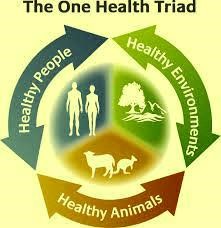One World, One Health: Preventing Zoonoses
Dr. Jitendra Singh, Deputy Chief Veterinary Officer , Jaunpur UP
Rabies: A Global Quest for Eradication
Rabies, a viral scourge that has haunted humanity for centuries, now stands on the precipice of elimination. This ancient enemy, transmitted primarily through the saliva of infected animals, especially through bites, carries a terrifying reputation: almost universally fatal once clinical symptoms appear. However, it is vital to understand that rabies is not invincible. A world where rabies-related deaths are a thing of the past is closer than ever before, thanks to concerted global efforts.
The One Health Imperative
At the heart of the battle against rabies is the “One Health” paradigm. This approach recognizes that the health of humans, animals, and ecosystems is inextricably linked. In the context of rabies, it means addressing the disease holistically, breaking the chain of transmission not only among humans but also among animals, especially dogs, which are responsible for most human rabies cases. The One Health approach embodies the collaborative spirit necessary for success.
Global Initiatives in the Fight Against Rabies
International organizations such as the World Health Organization (WHO), the World Organization for Animal Health (OIE), and the Food and Agriculture Organization (FAO) have joined forces to combat rabies. Their mission: to achieve zero human rabies deaths by 2030. This ambitious goal requires a multifaceted approach. Mass vaccination campaigns for dogs, enhanced access to post-exposure prophylaxis, and comprehensive public education campaigns have made substantial strides toward this aim.
Challenges and Hurdles
While progress has been substantial, hurdles remain. Low-income countries often lack the resources needed for mass dog vaccination, and deeply ingrained cultural beliefs sometimes hinder rabies prevention and reporting. The challenges may seem daunting, but they are not insurmountable. Global cooperation, innovative funding models, and culturally sensitive education efforts can help overcome these obstacles.
The Power of Education and Awareness
Education is an indispensable weapon in the war against rabies. Empowering communities with knowledge about rabies risks, responsible pet ownership, and recognizing the symptoms of rabies is a fundamental strategy. Simultaneously, healthcare professionals must be trained to identify and treat rabies cases promptly. Public awareness campaigns play a crucial role in dispelling myths, encouraging vaccination, and fostering a culture of responsibility.
A Blueprint for a Healthier Future
Rabies serves as a poignant illustration of the One Health approach in action, but its lessons extend far beyond this one disease. Embracing this holistic approach to health can yield sustainable solutions for other zoonotic diseases and broader environmental and public health challenges. By recognizing the interconnectedness of all life forms on our planet, we forge a path toward a healthier, more harmonious future.
Conclusion: A Future Without Fear
In conclusion, “Rabies: All for 1, One Health for All” is not just a slogan; it’s an achievable vision. By understanding the intricacies of rabies, embracing the One Health approach, supporting global initiatives, surmounting challenges, and prioritizing education and awareness, we pave the way toward a world where rabies is a relic of the past. In this future, we will have not only defeated a deadly disease but also exemplified the power of collective action and shared responsibility in public health. A future without the fear of rabies is within our grasp.
References:
- World Health Organization (WHO). (2021). Rabies. [Link](https://www.who.int/health-topics/rabies#tab=tab_1)
- World Organization for Animal Health (OIE). (2021). Rabies. [Link](https://www.oie.int/en/animal-health-in-the-world/rabies-portal/about-rabies/)
- Hampson, K., Coudeville, L., Lembo, T., Sambo, M., Kieffer, A., Attlan, M., … & Dodet, B. (2015). Estimating the global burden of endemic canine rabies. PLoS Neglected Tropical Diseases, 9(4), e0003709. [Link](https://journals.plos.org/plosntds/article?id=10.1371/journal.pntd.0003709)
- Rupprecht, C. E., Barrett, J., Briggs, D., Cliquet, F., Fooks, A. R., Lumlertdacha, B., … & Wandeler, A. I. (2008). Can rabies be eradicated? Development of a strategy for the global elimination of canine rabies. Expert Review of Vaccines, 7(6), 761-771. [Link](https://www.tandfonline.com/doi/full/10.1586/14760584.7.6.761)
- Zinsstag, J., Schelling, E., Roth, F., Bonfoh, B., de Savigny, D., & Tanner, M. (2007). Human benefits of animal interventions for zoonosis control. Emerging Infectious Diseases, 13(4), 527-531. [Link](https://wwwnc.cdc.gov/eid/article/13/4/06-1490_article)


